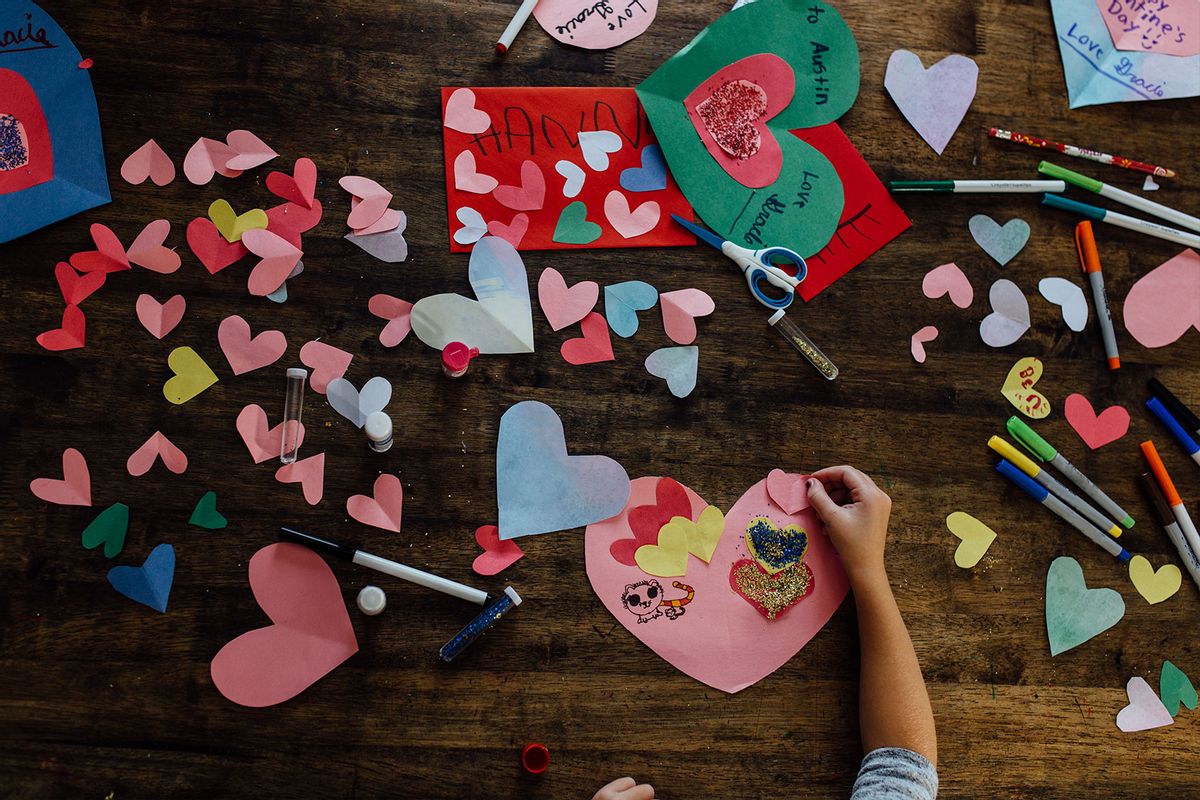If you haven't gotten them yet, it may already be too late. Valentines. And not for your sweetheart, not for your crush. For the 20 or likely many more small strangers in your child's class.
Gone are the days of cutting hearts from red construction paper and sending kids off with a shoebox to collect equally rudimentary holiday cards from classmates. Class valentines are now an expensive, elaborate and competitive business. And the burden of obtaining valentines and making them just right, like most things relating at all to parenthood, falls squarely upon moms.
The unspoken — or often, actually and clearly spoken — rule of school is that you must bring something for everyone in the class, or for no one. The first issue of class valentines is making sure no kid is left out, no name spelled incorrectly, which becomes difficult when dealing with young spellers, readers and writers. Writing out 30 classmates' names was a chore for my child, more homework than his actual homework at that age.
Don't get the slime — never get the slime.
But sometime between kindergarten and first or second grade, I noticed the valentines coming home were much fancier than the ones I had sent off in his backpack (along with larger cards for the teacher, teacher's aide, principal — and extras). Parents were giving away toys wrapped with cards, whole candy bars or cookies. A card was no longer enough. A handmade card was embarrassing.
A search for class valentines on Amazon pulls up pages of cards with something else: cards with pencils, balls, bracelets, plastic toys, fidget toys, sunglasses, slime (don't get the slime — never get the slime), art kits, rubber duckies, stress balls and more. There aren't any cards, not just cards, until well into the fourth page of results — and if you're going the plain card route, your selection is much more limited than if you wanted, say, finger puppet valentines or glow stick valentines or lip gloss valentines or foam airplane kit valentines.
One of the aspects I never anticipated about parenthood was how much plastic comes into the house, how many little tiny plastic crap things a child accumulates from well-meaning family, friends — or classmates on Valentine's Day. These valentines (and then some) also add up financially. This year, spending for Valentine's Day is expected to be almost $26 billion, making 2023 one of the highest spending years on record, according to CNBC. On average, Americans will spend $192.80 on Valentine's Day this year, up from last year, as CNBC reports, but their article on how to save money on Valentine's Day gives tips for couples only. Nothing about school valentines.
Back in 2017, ABC News reported, based on data from the Greeting Card Association, that Americans would spend $1 billion on cards for Valentine's Day. That's a lot of red.
Valentines, like the birthday treats of yore, have become a way to win friends and influence people, with moms as campaign managers.
The pressure and the race is on. At stake? Respect from your child's teacher — you didn't forget, you didn't leave anybody out — and most importantly, social status for your kid. Because like every messed-up thing about school (and probably, parenthood), Valentine's Day cards have become a competition. "Want to avoid a handmade fail?" reads a 2017 article from Today about school valentines, with the false-cheery tone of a Stepford Wife. Recommendations include $24 for a dozen Anthropologie valentines and video game-themed bracelets.
Valentines, like the birthday treats of yore, have become a way to win friends and influence people, with moms as campaign managers. Because the people shopping for perfect valentines, the people paying for them, making sure every name is correct and sending their children off to school safely with all the heart-shaped bribes are overwhelmingly women.
The class parents in my child's school every year? They call it a "parent," but it's not. It's a mom. Every year, every one.
Mothers do most of the unpaid, extra labor of school. The class parents in my child's school every year? They call it a "parent," but it's not. It's a mom. Every year, every one. The volunteers at the book fairs, the bakers of the bake sales? Moms. As Soraya Chemaly wrote in TIME, "Schools benefit hugely from the unpaid labor of mothers – most of whom, today, don't have the luxury of not needing jobs. The pressure to donate unpaid labor at schools is inextricably entwined with ideas about mothering and work. Every time volunteer cultures are gender imbalanced it is almost certainly a symptom of women's work being taken for granted, invisible and unpaid." Women volunteer more than men in general, according to the U.S. Bureau of Labor Statistics, but they're also more likely to volunteer for an educational group specifically (and for children's sports and recreation) than men.
Want a daily wrap-up of all the news and commentary Salon has to offer? Subscribe to our morning newsletter, Crash Course.
Our incredibly imbalanced view of parenthood, which rests so heavily on moms rather than dads, never stops, from the school nurse calling my number rather than my male partner's, to the clothes shopping responsibilities, the homework duties and the hunt for valentines. We're finally and begrudgingly starting to learn that holiday magic doesn't just happen, women make it happen. Moms make valentines happen too, with all the cards' pressure, expense and expectation, and maybe it's time we return that to sender.



Shares